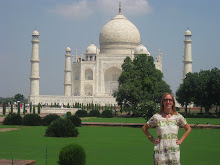 This Sunday was the last Sunday night for three months that I will spend snuggling with my husband and watching bad t.v. Next Sunday night I will be airborn. Then every Sunday after that until October 26th, I will be in my apartment in New Delhi.
This Sunday was the last Sunday night for three months that I will spend snuggling with my husband and watching bad t.v. Next Sunday night I will be airborn. Then every Sunday after that until October 26th, I will be in my apartment in New Delhi.This entire week is punctuated by thoughts of "This is the last time I'll do [insert experience here] for three months."
One thing I will miss is just delivering the news that I will be spending three months in India to people. It's been delicious to see their widening eyes and sometimes even dropping jaws. I even enjoyed the slight disorientation at the pharmacy when I passed over my prescriptions for typhoid vaccine and malaria drugs. "Do we have this in stock?" the mumblings went on behind the counter.
Many more people have been wholly excited and supportive than not, but the very few who evinced skeptical reactions also took me aback. I got a lot of "They don't have toilets there," and, "You must be training your replacement."
Just for the record, they do have toilets in India, and I am not training my replacement.
Because it's the (Indian) elephant in the room (they have smaller ears), I'll address it briefly here. Outsourcing is an issue that has created a lot of angst in the United States. I've never lost a job because it moved overseas, but I've seen it happen around me, and it's clearly a point of pain for those who experience it. I'm not sure what more to say except that it's clear that the idea of "India" in Western minds has taken on connotations beyond the romantic exoticism of colonial times. In fact, it seems like this image has been wholly ecplipsed in some people's minds.
Back to the Surreal o'Meter: there is the idea of India, then there is the reality. I think it's safe to say that people whose reactions to my news were totally negative have a one-dimensional picture of this country, a picture that entails millions of people working ex-American IT and calling center jobs, perhaps even a picture that includes Indian nationals setting out purposefully to "steal" American jobs.
Perhaps I was previously naive, but talking about my impending trip with the various people I've encountered has alerted me to a kind of prejudice that I hadn't previously thought much about. I wonder how often Indian people run into this kind of resentment in our country. If I've encountered it in my very limited experience, I'd have to assume that it's not a rare occassion.
Boiling these issues down to a matter of race or country of origin makes no sense, but it's certainly easier than the kind of complex economical analysis you'd have to carry out to understand the market forces driving the outsourcing phenomenon.
The opportunity to participate in the New Directions program is nothing if not a learning experience, and I expect to learn the good and the bad--and find it all useful, if only so I can be more sensitive to such issues in the workplace.
On the bright side, those with negative attitudes are far outnumbered by people who have a more complex picture of the country in mind, or who have actually visited there, or who are from there, or who retain a wonderful sense of curiosity about life on the other side of the world.
While my trip is suddenly seeming very real to me as I count down the days, India is still just a stew of ideas to me, and I can't wait to start adding the real ingredients.
Six days 'til departure!


